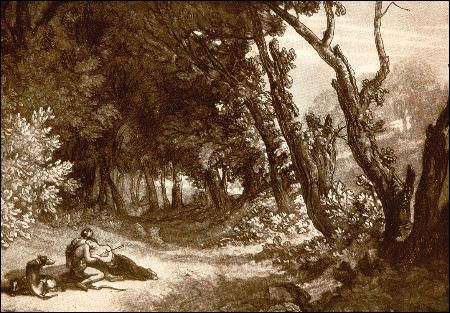
By Kind Permission of a Private Collection

By Kind Permission of a Private Collection
Drawn and etched by Turner. Engraved in mezzotint by Clint. Dated 1812 and published in Part 8 of the Liber Studiorum ( Finberg 41). Category: Historical. (See Forrester, pp.101-02.)
In Modern Painters II (1846), Ruskin draws attention to the symbolic value of the dying rays of light in the composition ( Works, 4.309). In Modern Painters III (1856), he includes this plate in a list of 'the finest works in the book', asserting that it was drawn 'under the influence of Titian' ( Works, 5.399). In his Notes on the Turner Gallery (1856) he again includes it in a list of the 'best of the series' ( Works, 13.96). In The Elements of Drawing (1857), he recommends study of it as one of the 'most desirable' Liber Studiorum subjects, and draws attention to the fine etching ( Works, 15.98-99). In Lectures on Landscape (1871) the plate is interpreted as portraying 'the death of the body by the impatience and error of love' ( Works, 22.65).
In Modern Painters II (1846), Procris and Cephalus is discussed as a fine example of the use of the associative imagination ( Works, 4.245), in which regard it is symbolic of Ruskin 's approach to the Liber Studiorum as a whole: see The Liber Studiorum and the associative imagination.
J.M.W. Turner 1775-1851
Procris and Cephalus ?c.1807-8
Pencil and watercolour on off-white wove writing paper, 18.5x26cm
Engraving:
Engraved by G. Clint, 1812
Mezzotint engraving, 18x26cm
Engraved for the Liber Studiorum, part 8
Provenance: Turner Bequest, 1856 (CXVII P)
Collection: Tate Gallery, London